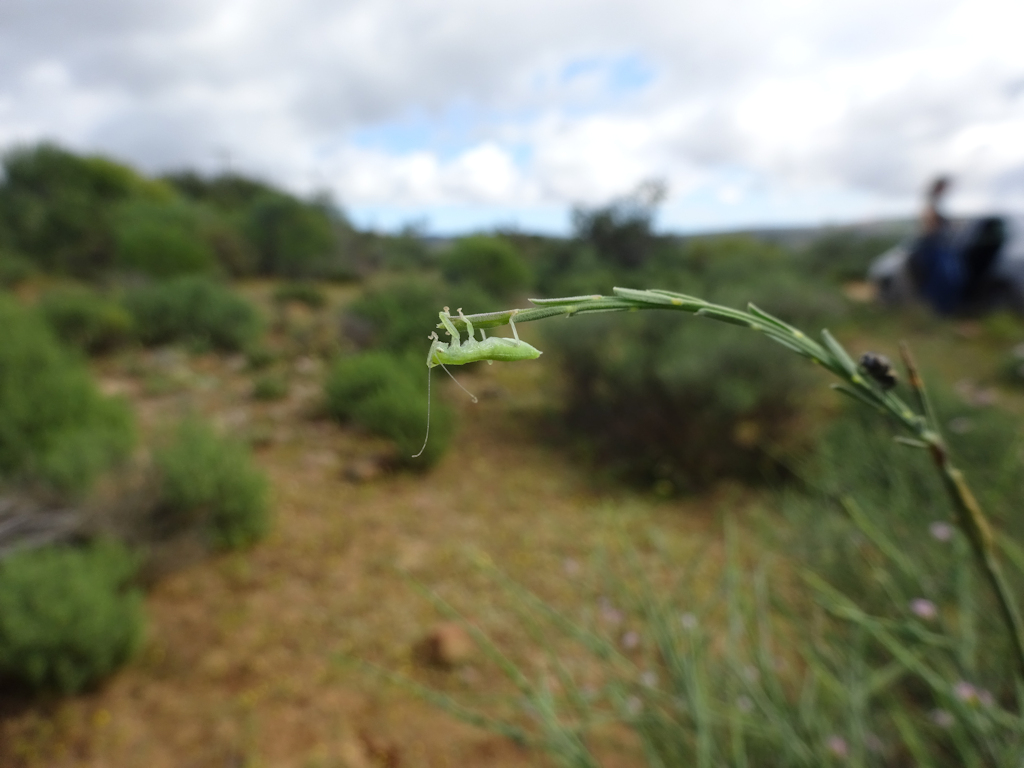Vibrational Communication Signals in Mantophasmatodea: Species Recognition, Sexual Selection, and Population Differentiation
Project description
In the DFG-funded project, Monika Eberhard and Serena Dool investigated vibratory signals at a fine scale, namely the variability of signals as well as preferences for signal traits within and between individuals of different populations of the same species, to reveal processes that have shaped the signals and differentiation among them.
The insect order Mantophasmatodea (heelwalkers) was described in 2002; the first new insect order discovered in nearly a century. Extant members of this order are only known from semi-arid and arid regions of Namibia and south-western South Africa. Male and female heelwalkers communicate via substrate vibrations that are produced by tapping the abdomen on the substrate surface. Males have a pronounced drumming organ on the subgenital plate, while females tap in the absence of any specialized organ.
Vibrational signals of Mantophasmatodea are species- and gender-specific, and are of great importance for species recognition and mate localization. They may also play a role in mate choice. The signals are detected by very sensitive leg scolopidial organs which are broadly tuned to the frequency of the communication signals.
As Mantophasmatodea use quite simple vibratory signals produced by percussion or drumming, they are an ideal model system to answer various important questions concerning the evolution of vibrational signals: Behavioural experiments assess the decisive cues within vibrational communication calls, which are used for species recognition. We explore if males transfer any information about their condition (size, feeding or mating status, etc.) to the females via the vibratory signals they produce, and if male signals also depend on environmental conditions such as temperature. Female preferences are investigated using playback experiments with artificial vibrational signals to reveal the influence of sexual selection on vibrational signal evolution. Finally, variability of vibrational calls, variability of somatic and genitalic morphological characters as well as genetic diversity using microsatellite markers are investigated in populations of the same species to reveal the present state of population differentiation of Mantophasmatodea in the Western Cape. This provides insight into the role vibrational communication might play for population differentiation and speciation in Mantophasmatodea.
Collaborations:
Mike D. Picker, Department of Zoology, University of Cape Town, South Africa
Martin Haase & Gabriele Uhl, Zoological Institute and Museum, University of Greifswald
Klaus-Dieter Klass, Museum für Tierkunde, Senckenberg Naturhistorische Sammlungen Dresden, Germany
- Eberhard, M.J.B.; Schoville, S.D. & Klass, K-D. In press. Biodiversity of Grylloblattodea and Mantophasmatodea. In: Insect Biodiversity II: Science and Society, Foottit R.G. & Adler H. (Eds.), Wiley.
- Dool, S. E.; Kuenzel, S.; Haase, M.; Picker, M. D. & Eberhard, M. J. B. 2018 Variable molecular markers for the order Mantophasmatodea (Insecta). Journal of Heredity 109: 477-483.
- Eberhard, M.J.B. & Eberhard, S.H. 2013: Evolution and Diversity of Vibrational Signals in Manto-phasmatodea (Insecta). Journal of Insect Behavior 26: 352–370.
- Eberhard, M.J.B.; Picker, M.D. & Klass, K.-D. 2011: Sympatry in Mantophasmatodea, with the description of a new species and phylogenetic considerations. Organisms Diversity and Evolution 11: 43-59.
- Eberhard, M.J.B.; Lang, D.; Metscher, B.; Pass, G.; Picker, M.D. & Wolf, H. 2010: Structure and sensory physiology of the leg scolopidial organs in Mantophasmatodea and their role in vibrational communication. Arthropod Structure & Development 39: 230-241.
- Eberhard, M.J.B.; Pass, G.; Picker, M.D.; Beutel, R.; Predel, R.; Gorb, S.N. 2009: Structure and Function of the Arolium of Mantophasmatodea (Insecta). Journal of Morphology 270: 1247-1261.
- Eberhard, M.J.B. 2009: Kurze Vorstellung der Ordnung Mantophasmatodea. Entomologica Austriaca 16: 73-84.
- Eberhard, M.J.B. & Picker, M.D. 2008: Vibrational Communication in two sympatric species of Mantophasmatodea (Heelwalkers). Journal of Insect Behavior 21: 240-257.





